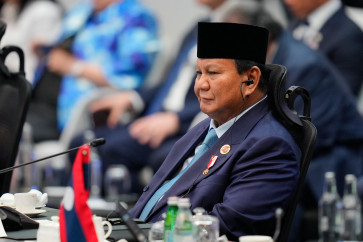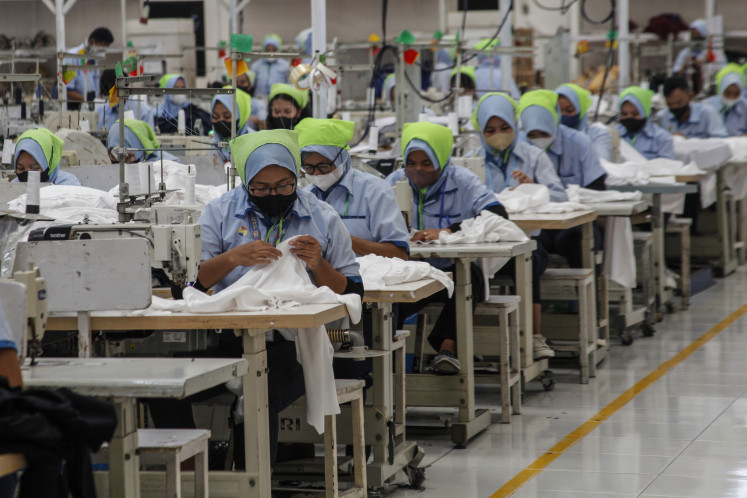Popular Reads
Top Results
Can't find what you're looking for?
View all search resultsPopular Reads
Top Results
Can't find what you're looking for?
View all search resultsA grim reality behind Indonesia's car sales drop
Another best selling car: People look over a low-cost green car (LCGC), the Honda Brio Satya, during a recent exhibition
Change text size
Gift Premium Articles
to Anyone
 Another best selling car: People look over a low-cost green car (LCGC), the Honda Brio Satya, during a recent exhibition. The car was the third best selling LCGC in Indonesia in 2015, according to a report by the Association of Indonesian Automotive Manufacturers (Gaikindo). (JP/R. Berto Wedhatama) (LCGC), the Honda Brio Satya, during a recent exhibition. The car was the third best selling LCGC in Indonesia in 2015, according to a report by the Association of Indonesian Automotive Manufacturers (Gaikindo). (JP/R. Berto Wedhatama)
Another best selling car: People look over a low-cost green car (LCGC), the Honda Brio Satya, during a recent exhibition. The car was the third best selling LCGC in Indonesia in 2015, according to a report by the Association of Indonesian Automotive Manufacturers (Gaikindo). (JP/R. Berto Wedhatama) (LCGC), the Honda Brio Satya, during a recent exhibition. The car was the third best selling LCGC in Indonesia in 2015, according to a report by the Association of Indonesian Automotive Manufacturers (Gaikindo). (JP/R. Berto Wedhatama)
A
span class="caption">Another best selling car: People look over a low-cost green car (LCGC), the Honda Brio Satya, during a recent exhibition. The car was the third best selling LCGC in Indonesia in 2015, according to a report by the Association of Indonesian Automotive Manufacturers (Gaikindo). (JP/R. Berto Wedhatama)
Indonesia has seen a 9.9 percent drop in January car sales, down from a year earlier, suggesting that the low oil price may not have helped to boost automobile sales.
For a country that depends on oil and imports nearly half of its required 1.6 million barrels per day, a lower oil price is supposed to fuel the economy. And for Indonesians'who oft acknowledge that poor public transportation is a problem' a lower oil price, in theory, should add fuel to the desire to purchase a car.
The relation between oil price and automotive sales is discussed in a study Thomas K. Lee published in the Journal of Monetary Economics in 2002. In the study, Thomas, a researcher at the US Energy Information Administration, shows that motor vehicle sales and output are hit worst during an oil price upsurge.
Theoretically, a decline in the oil price should allow car manufacturers to cut car prices to lure consumers. Amid low oil prices, the cost of manufacturing synthetic tires drop, the cost of heating tire and car manufacturing factories also drops, and shipping costs decrease as well.
But that's not what happened in Indonesia. Automotive industry association (Gaikindo) data shows that the industry sold 84,885 cars in January, a 9.9 percent drop year-on-year. Looking further, cars sales have plunged persistently over the past three years following the oil price drop.
Reporting 1.23 million in sales for 2013, the industry proceeded to record a 1.6 percent sales drop to 1.21 million in 2014. A year later, the figure dropped a further 17 percent to 1 million. It's an exponential crash, from a 20,000 sales decline in 2014 to a plunge of more than 200,000 in sales in 2015.
An analyst at KBD Daewoo Securities Maxi Liesyaputra has predicted that the automotive industry will continue to face challenges in 2016, given a weakening rupiah against the US dollar. He estimated the average currency at Rp 14,500 in 2016, lower than the 2015 average of Rp 13,400.
'The lower subsidized fuel price that started on January 5, down 4.7 percent to Rp 7,050 per liter for Ron 88 and 15.7 percent to Rp 5,650 per liter for diesel solar, will not significantly impact car sales growth,' he said in a note to investors.
For the automotive industry, the weakening rupiah has led to higher production costs while tighter competition has led to price cuts, Maxi added. As Indonesia's rupiah has been squeezed by the US dollar, the lower oil price has been of benefit to the US economy, while at the same time has weakened the Indonesian economy.
Oil dependency
The problem goes back to Indonesia's significant exposure to the global oil industry. While the country's dependency on the main fuel of the world persists, the infrastructure to process oil remains limited with a lack of refineries and storage facilities.
"We still have problems with the law. The current ones are not strong enough to support refineries and storage development. We still need to rectify this, along with attracting investors," the Energy and Mineral Resources Ministry's director for oil and gas, IGN Wiratmaja Puja said.
It explains why Indonesia is unable to maximize the price drop by increasing its oil stocks. In January, the country has recorded its lowest oil and gas imports, amounting to US$1.2 billion.
According to the Central Statistics Agency (BPS), oil and gas imports in January fell 32.1 percent, compared to December 2015. Total oil and gas imports were reportedly slashed by 42.3 percent for the year.
The oil glut, due to economic slowdown, is the driver of this ironic situation. The country's two main commodities, coal and crude palm oil (CPO)'contributing one third of the country's export total'are heavily shaped by oil. Each drop in the oil price leads to a drop in the price of both commodities and hits the Indonesian economy.
As Indonesia's crude oil price market fell from $35.5 per barrel in Dec. 2015 to $27.5 in January, state revenue was estimated to subside by Rp 90 trillion for 2016. "In 2014 oil and gas contributed 20 percent of total revenue and only 10 percent in 2015," said Finance Minister Bambang Brodjonegoro at a working meeting with the House's budgetary body in Jakarta on Feb. 17.
For consumers, a drop in oil price, provides a natural stimuli in the form of lower fuel spending and moderate inflation. However, consumers are just as likely to keep the stimulus as savings, rather than utilize it for additional spending, because they are facing a challenging economy with layoffs in some places and lower sales and exports.
Local industries have hinted a lower production activity in the future as indicated by the drop in capital goods and raw materials imports in the first month of the year. Both imports registered a year-on-year drop of 22 percent and 18.6 percent respectively.
"The decline in the import of raw materials indicates that an increasing number of industries are using domestic raw materials," BPS head Suryamin said in an optimistic tone, seeming to ignore the fact that many of these raw materials such as petrochemical, cereal, or dairy, are yet to be produced locally.
The drop in car sales in the last two years signifies a decline in purchasing power among Indonesia's middle-class, totaling around 60 percent of the population. The global slowdown and the oil glut has ultimately shown a crystal clear effect on the biggest market in ASEAN.
An oil dependency is an irony for Indonesia whose 112 gigawatt-peak (GWp) potential solar energy wasted. Not to mention that it sits on a 'ring of fire' volcanoes with thousands kilometers of coastlines, leaving 300 gigawatt (GW) of potential geothermal power and 700 GW of potential sea wave energy idle.
Without a revolutionary solution to this systemic problem, the same classical issue will continue, worsening in the next two decades when oil-stock in the country'as predicted by the Oil and Gas Regulator (SKK Migas)'ultimately drains out. (ags)
---
thejakartapost.com reporter Anton Hermansyah in Jakarta contributed to this story.









